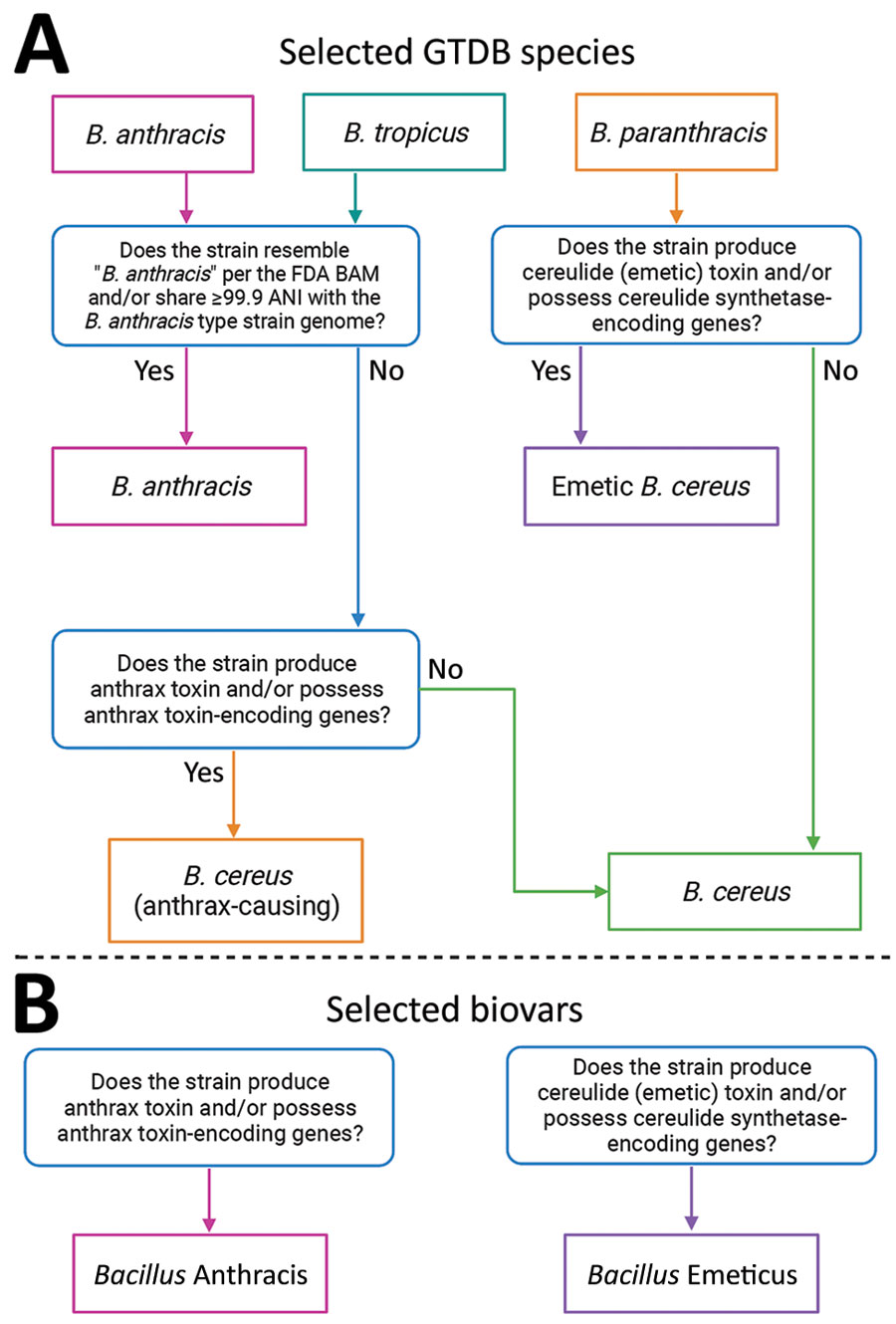Volume 28, Number 9—September 2022
Dispatch
Laboratory Misidentifications Resulting from Taxonomic Changes to Bacillus cereus Group Species, 2018–2022
Figure 2

Figure 2. Flowcharts of Bacillus species and biovar name assignments. A) Flowchart depicting how 3 Bacillus species names assigned using GTDB releases R95 and R202 can be translated to historically important or colloquial names for B. cereus group species, as outlined in the US FDA’s BAM (5). B) Chart depicting how anthrax and cereulide (emetic) toxin-producing strains can be referred to using a previously proposed standardized collection of B. cereus group biovar terms (6). Figure was created using BioRender.com. ANI, average nucleotide identity; BAM, Bacteriological Analytical Manual; FDA, Food and Drug Administration; GTDB, Genome Taxonomy Database.
References
- Stenfors Arnesen LP, Fagerlund A, Granum PE. From soil to gut: Bacillus cereus and its food poisoning toxins. FEMS Microbiol Rev. 2008;32:579–606. DOIPubMedGoogle Scholar
- Baldwin VM. You can’t B. cereus—a review of Bacillus cereus strains that cause anthrax-like disease. Front Microbiol. 2020;11:1731. DOIPubMedGoogle Scholar
- Bottone EJ. Bacillus cereus, a volatile human pathogen. Clin Microbiol Rev. 2010;23:382–98. DOIPubMedGoogle Scholar
- Jovanovic J, Ornelis VFM, Madder A, Rajkovic A. Bacillus cereus food intoxication and toxicoinfection. Compr Rev Food Sci Food Saf. 2021;20:3719–61. DOIPubMedGoogle Scholar
- Tallent SM, Knolhoff A, Rhodehamel EJ, Harmon SM, Bennett RW. Bacillus cereus. In: Bacteriological analytical manual (BAM). 8th ed. Silver Spring (MD): Food and Drug Administration; 2019.
- Carroll LM, Wiedmann M, Kovac J. Proposal of a taxonomic nomenclature for the Bacillus cereus group which reconciles genomic definitions of bacterial species with clinical and industrial phenotypes. MBio. 2020;11:e00034–20. DOIPubMedGoogle Scholar
- Carroll LM, Cheng RA, Wiedmann M, Kovac J. Keeping up with the Bacillus cereus group: taxonomy through the genomics era and beyond. Crit Rev Food Sci Nutr. 2021;•••:1–26. DOIPubMedGoogle Scholar
- Balloux F, Brønstad Brynildsrud O, van Dorp L, Shaw LP, Chen H, Harris KA, et al. From theory to practice: translating whole-genome sequencing (WGS) into the clinic. Trends Microbiol. 2018;26:1035–48. DOIPubMedGoogle Scholar
- Guinebretière MH, Velge P, Couvert O, Carlin F, Debuyser ML, Nguyen-The C. Ability of Bacillus cereus group strains to cause food poisoning varies according to phylogenetic affiliation (groups I to VII) rather than species affiliation. J Clin Microbiol. 2010;48:3388–91. DOIPubMedGoogle Scholar
- Liu Y, Du J, Lai Q, Zeng R, Ye D, Xu J, et al. Proposal of nine novel species of the Bacillus cereus group. Int J Syst Evol Microbiol. 2017;67:2499–508. DOIPubMedGoogle Scholar
- Carroll LM, Wiedmann M. Cereulide synthetase acquisition and loss events within the evolutionary history of group III Bacillus cereus sensu lato facilitate the transition between emetic and diarrheal foodborne pathogens. MBio. 2020;11:e01263–20. DOIPubMedGoogle Scholar
- Madoroba E, Magwedere K, Chaora NS, Matle I, Muchadeyi F, Mathole MA, et al. Microbial communities of meat and meat products: an exploratory analysis of the product quality and safety at selected enterprises in South Africa. Microorganisms. 2021;9:507. DOIPubMedGoogle Scholar
- Carroll LM, Pierneef R, Mathole A, Atanda A, Matle I. Genomic surveillance of Bacillus cereus sensu lato strains isolated from meat and poultry products in South Africa enables inter- and intra-national surveillance and source tracking. Microbiol Spectr. 2022;10:
e0070022 . DOIPubMedGoogle Scholar - Chaumeil PA, Mussig AJ, Hugenholtz P, Parks DH. GTDB-Tk: a toolkit to classify genomes with the Genome Taxonomy Database. Bioinformatics. 2019;•••:
btz848 . DOIPubMedGoogle Scholar
Page created: July 31, 2022
Page updated: August 19, 2022
Page reviewed: August 19, 2022
The conclusions, findings, and opinions expressed by authors contributing to this journal do not necessarily reflect the official position of the U.S. Department of Health and Human Services, the Public Health Service, the Centers for Disease Control and Prevention, or the authors' affiliated institutions. Use of trade names is for identification only and does not imply endorsement by any of the groups named above.